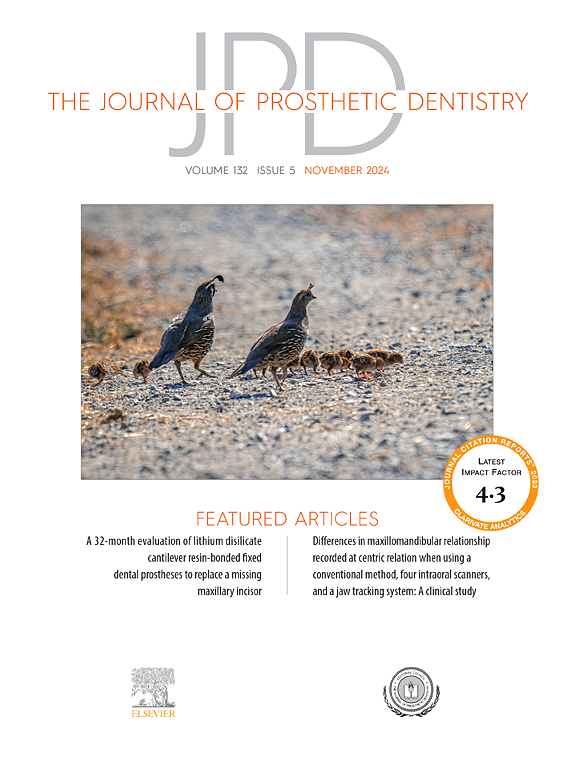基于人工智能的程序对使用口内扫描仪获取的扫描结果进行上下颌骨关系定位的准确性。
IF 4.8
2区 医学
Q1 DENTISTRY, ORAL SURGERY & MEDICINE
引用次数: 0
摘要
问题陈述:基于人工智能(AI)的程序可用于在最大牙间隙位置(MIP)上衔接扫描,或在MIP上纠正衔接扫描的咬合碰撞;然而,人工智能程序确定MIP关系的准确性尚不清楚。目的:本临床研究的目的是评估口内扫描仪(IOS)(TRIOS 5或i700)和程序(IOS或基于AI的程序)对MIP关系准确性的影响:将一名参与者安装在发音器上的模型数字化(T710)。使用 2 种 IOS 系统记录受试者的上颌和下颌扫描结果,分别为 TRIOS 5 和 i700:TRIOS 5 和 i700。扫描重复 15 次。然后,在 MIP 中使用双侧咬合记录对每对重复扫描进行衔接。根据使用相应的 IOS 程序完成的自动咬合碰撞校正,将复制的衔接扫描分为两组:IOS校正组和IOS未校正组。根据基于人工智能程序(咬合查找器)的方法创建了三个分组:AI-关节化组、AI-IOS-校正组和AI-IOS-非校正组(n=15)。在人工智能衔接亚组中,非衔接扫描被导入并衔接。在人工智能-IOS校正亚组中,导入在人工智能-IOS校正组中获得的铰接扫描,并校正咬合碰撞。在经过 AI-IOS 校正的子组中,导入了 IOS 未校正子组中获得的衔接扫描,并校正了咬合碰撞。在每个衔接扫描(Geomagic Wrap)上共计算了 36 个地标间测量值。以参考扫描计算的距离为参照,计算与每个实验扫描的差异。采用非参数双向方差分析和成对多重比较 Dwass-Steel-Critchlow-Fligner 检验来分析真实度。采用一般线性模型程序分析精确度(α=.05):结果:上下颌骨的真实度(P=.003)和精确度(PConclusions)均显著提高:测试的 IOS 获得了相似的 MIP 精确度;但是,用于衔接或纠正咬合碰撞的程序影响了 MIP 关系的精确度。本文章由计算机程序翻译,如有差异,请以英文原文为准。
Accuracy of an artificial intelligence-based program for locating the maxillomandibular relationship of scans acquired by using intraoral scanners
Statement of problem
An artificial-intelligence (AI) based program can be used to articulate scans in maximum intercuspal position (MIP) or correct occlusal collisions of articulated scans at MIP; however, the accuracy of the AI program determining the MIP relationship is unknown.
Purpose
The purpose of the present clinical study was to assess the influence of intraoral scanner (IOS) (TRIOS 5 or i700) and program (IOS or AI-based program) on the accuracy of the MIP relationship.
Material and methods
Casts of a participant mounted on an articulator were digitized (T710). A maxillary and a mandibular scan of the participant were recorded by using 2 IOSs: TRIOS 5 and i700. The scans were duplicated 15 times. Then, each duplicated pair of scans was articulated in MIP using a bilateral occlusal record. Articulated scans were duplicated and allocated into 2 groups based on the automatic occlusal collisions’ correction completed by using the corresponding IOS program: IOS-corrected and IOS-noncorrected group. Three subgroups were created based on the AI-based program (Bite Finder) method: AI-articulated, AI-IOS-corrected, and AI-IOS-noncorrected (n=15). In the AI-articulated subgroup, the nonarticulated scans were imported and articulated. In the AI-IOS-corrected subgroup, the articulated scans obtained in the IOS-corrected group were imported, and the occlusal collisions were corrected. In the AI-IOS-corrected subgroup, the articulated scans obtained in the IOS-noncorrected subgroup were imported, and the occlusal collisions were corrected. A total of 36 interlandmark measurements were calculated on each articulated scan (Geomagic Wrap). The distances computed on the reference scan were used as a reference to calculate the discrepancies with each experimental scan. Nonparametric 2-way ANOVA and pairwise multiple comparison Dwass-Steel-Critchlow-Fligner tests were used to analyze trueness. The general linear model procedure was used to analyze precision (α=.05).
Results
Significant maxillomandibular trueness (P=.003) and precision (P<.001) differences were found among the subgroups. The IOS-corrected and IOS-noncorrected (P<.001) and AI-articulated and IOS-noncorrected subgroups (P=.011) were significantly different from each other. The IOS-corrected and AI-articulated subgroups obtained significantly better maxillomandibular trueness and precision than the IOS-noncorrected subgroups.
Conclusions
The IOSs tested obtained similar MIP accuracy; however, the program used to articulate or correct occlusal collusions impacted the accuracy of the MIP relationship.
求助全文
通过发布文献求助,成功后即可免费获取论文全文。
去求助
来源期刊

Journal of Prosthetic Dentistry
医学-牙科与口腔外科
CiteScore
7.00
自引率
13.00%
发文量
599
审稿时长
69 days
期刊介绍:
The Journal of Prosthetic Dentistry is the leading professional journal devoted exclusively to prosthetic and restorative dentistry. The Journal is the official publication for 24 leading U.S. international prosthodontic organizations. The monthly publication features timely, original peer-reviewed articles on the newest techniques, dental materials, and research findings. The Journal serves prosthodontists and dentists in advanced practice, and features color photos that illustrate many step-by-step procedures. The Journal of Prosthetic Dentistry is included in Index Medicus and CINAHL.
 求助内容:
求助内容: 应助结果提醒方式:
应助结果提醒方式:


